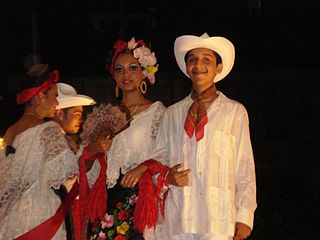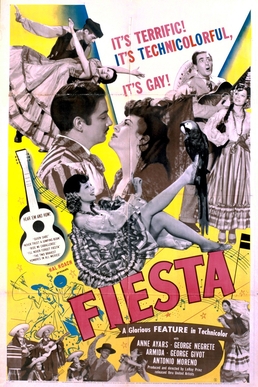Related Research Articles

The Three Caballeros is a 1944 American live-action and animated musical propaganda anthology film produced by Walt Disney and released by RKO Radio Pictures. The film premiered in Mexico City on December 21, 1944. It was released in the United States on February 3, 1945 and in the United Kingdom in March 1945. It marks the tenth anniversary of Donald Duck and plots an adventure through parts of Latin America, combining live-action and animation. This is the second of the six package films released by Walt Disney Productions in the 1940s, following Saludos Amigos (1942). It is also notable for being one of the first feature-length films to incorporate traditional animation with live-action actors.

The music of Mexico is highly diverse, featuring a wide range of musical genres and performance styles. It has been influenced by a variety of cultures, primarily deriving from Europeans, Indigenous, and Africans. Music became an expression of Mexican nationalism starting in the nineteenth century.
Bolero is a genre of song which originated in eastern Cuba in the late 19th century as part of the trova tradition. Unrelated to the older Spanish dance of the same name, bolero is characterized by sophisticated lyrics dealing with love. It has been called the "quintessential Latin American romantic song of the twentieth century".

Mariachi is an ensemble of musicians that typically play ranchera, the regional Mexican music dating back to at least the 18th century, evolving over time in the countryside of various regions of western Mexico. The usual mariachi group today consists of as many as eight violins, two trumpets and at least one guitar, including a high-pitched vihuela and an acoustic bass guitar called a guitarrón, and all players taking turns singing lead and doing backup vocals.

Originally, Trio Los Panchos were a trío romántico formed in New York City in 1944 by Alfredo Gil, Chucho Navarro, and the Puerto Rican Hernando Avilés. The trio became one of the leading exporters of the bolero and the romantic ballad in Latin America.

Huapango is a family of Mexican music styles. The word likely derives from the Nahuatl word cuauhpanco that literally means 'on top of the wood', alluding to a wooden platform on which dancers perform zapateado dance steps. It is interpreted in different forms, the most common being the classic huapango interpreted by a trio of musicians ; the huapango norteño interpreted by a group ; and the huapango de mariachi, which can be performed by a large group of musicians.

Regional styles of Mexican music vary greatly from state to state. Norteño, banda, duranguense, Son mexicano and other Mexican country music genres are often known as regional Mexican music because each state produces different musical sounds and lyrics.

Alfredo Bojalil Gil, also known by his nickname El güero, was a Mexican singer and the creator and principal founding member of the musical trio, Trio Los Panchos. As a member of Los Panchos, he was the third voice and player of the requinto, a small guitar which he invented, and is now a staple instrument.

Chris-Pin Martin was an American character actor whose specialty lay in portraying comical Mexicans, particularly sidekicks in The Cisco Kid film series. He acted in over 100 films between 1925 and 1953, including over 50 westerns.

Son jarocho is a regional folk musical style of Mexican Son from Veracruz, a Mexican state along the Gulf of Mexico. It evolved over the last two and a half centuries along the coastal portions of southern Tamaulipas state and Veracruz state, hence the term jarocho, a colloquial term for people or things from the port city of Veracruz.

Son huasteco is one of eight Mexican song styles and is a traditional Mexican musical style originating in the six state area of Northeastern Mexico called La Huasteca. It dates back to the end of the 19th century and is influenced by Spanish and indigenous cultures. Usually it is played by a Trio Huasteco composed of a guitarra quinta huapanguera a Jarana huasteca and a violin. Singers will often use the falsetto register. The son huasteco is particularly noteworthy for its flamboyant and virtuoso violin parts, although the style varies from state to state. Footwork often danced to son huasteco is the Zapateado. Improvisation plays a strong role in the style, with musicians creating their own lyrics and arrangements to a standard repertoire. Typical sones huastecos are "Cielito Lindo", "La huazanga", "La sirena", "El querreque" and "La cigarra".

In Mexican Spanish, Jarocho is a colloquial demonym for residents of the State of Veracruz, Mexico, as well as an appellative term for anything related to said state.

Quetzal is a bilingual (Spanish-English) Chicano rock band from East Los Angeles, California.

Gabriel Siria Levario, known professionally as Javier Solís, was a Mexican singer and actor. He specialized in the musical genres of bolero and ranchera.
Son de Madera is a son jarocho band based in Veracruz, Mexico. Its core members are Ramón Gutiérrez Hernández, Tereso Vega, and Rubí Oseguera Rueda. The band was founded in 1992 by Ramón Gutiérrez and Laura Rebolloso.

Fiesta is a 1941 American Technicolor musical film directed by LeRoy Prinz that was one of Hal Roach's Streamliners. The film was the motion picture debut of the Los Angeles Civic Light Opera star Anne Ayars.
"¡Ay, Jalisco, no te rajes!" or in English Jalisco, don't back down is a Mexican ranchera song composed by Manuel Esperón with lyrics by Ernesto Cortázar Sr. It was written in 1941 and featured in the 1941 Mexican film ¡Ay Jalisco, no te rajes!, after which it became an enormous hit in Mexico. The melody of the song was used for the title song of the Disney film The Three Caballeros. Both songs have been recorded by many artists.
Felipe Gil, also known by his nickname El Charro was a Mexican singer and songwriter of the Golden Age of Mexican cinema. He was born in Misantla, Veracruz, in 1913, into a family of musicians and he studied the music of the area. He worked for a time with Álvaro Ancona and in 1936 they were joined by Jesús "Chucho" Navarro, forming the group El Charro Gil y Sus Caporales. In 1940 Ancona was replaced by Felipe's brother Alfredo Gil. They disbanded in 1944, when Chucho Navarro and Alfredo Gil left the group to form the Trío Los Panchos with Hernando Avilés.

Son mexicano is a style of Mexican folk music and dance that encompasses various regional genres, all of which are called son. The term son literally means "sound" in Spanish, and is also applied to other unrelated genres, most notably son cubano.
Eva Garza was a Mexican-American singer and film actress who acquired international recognition in the 1940s and 1950s during the Golden Age of Mexican cinema. She collaborated on live radio shows and films with some of the leading performers of her time, including Mexico's Agustín Lara. She was nicknamed "Sweetheart of the Americas".
References
- 1 2 Dave Smith. "Ask Dave". D23. Archived from the original on January 10, 2012. Retrieved January 13, 2012.
"Lilongo" was written by Felipe "El Charro" Gil, and copyrighted in the U.S. by the music publisher Peer International Corp. in 1946. It is in the Son Jarocho style, a traditional musical style of the southern part of the Mexican state of Veracruz. Gil was born in Misantla, Veracruz, in 1913, into a family of musicians, and he made a study of the music of the area.
- 1 2 Spottswood, Richard (1990). Ethnic Music on Records Volume 4 Spanish, Portuguese, Philippine, Basque: A Discography of Ethnic Recordings Produced in the United States, 1893-1942. University of Illinois Press.
- ↑ "Recordando al Trio Los Panchos Mexicantos". eltriolospanchos.com. Archived from the original on January 22, 2013. Retrieved January 13, 2012.